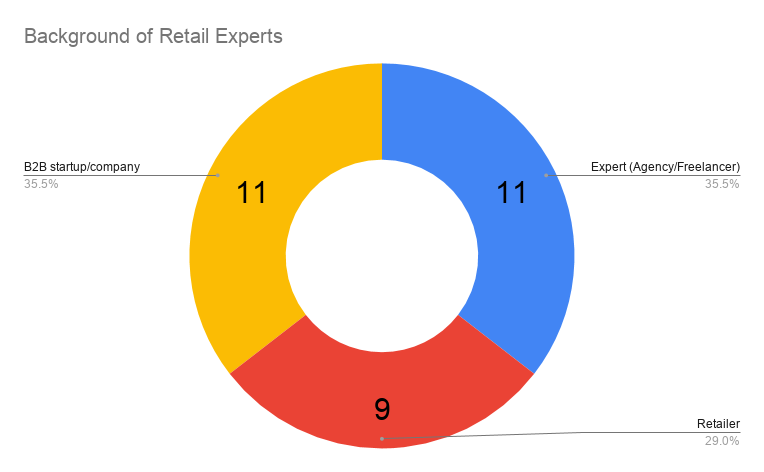2019 was another glorious year for the retail sector, with sales reaching $25 trillion worldwide, according to eMarketer. Unsurprisingly, the key growth driver was eCommerce, which grew over 16% year over year, accounting for $3.46 trillion (~14% of total retail sales).
“Online retail grows twice as fast as the rest eCommerce sector and 5 times higher than the global retail sector.
As eCommerce penetration is expected to rise from 56.1% in 2020 to 65.5% by 2024, a major trend to watch is around how retailers can capitalize on their brand assets, starting with their physical stores, which account for a majority of their revenue. At the same time, there is ever-increasing competition among retailers to lead the technology game. When Amazon invested $23 billion in technology, Walmart followed with $11 billion (2018) investment as well. The adoption of new technologies is a crucial ingredient for retailers to avoid bankruptcy and scale in numbers.
Sad fact: In 2019 alone, there were 81 retail bankruptcies in the US.
So what are the top retail marketing trends of 2020? Where are the retail companies going to focus on their investments this year? We asked 31 retail and marketing professionals to share their insights on top retail marketing trends for 2020 and the years ahead.
Table of Contents
- Expert Predictions: Top Retail Marketing Trends of 2020
- Retail Expert #1: Yigit Kocak, Inbound Marketing Manager at Prisync
- Retail Expert #2: Nikola Baldikov, Digital Marketing Manager at Brosix
- Retail Expert #3: Celeste Huffman, Marketing at Rogers and Hollands
- Retail Expert #4: Tytus Golas, Founder and CEO of Tidio Live Chat
- Retail Expert #5: Jordie van Rijn, Founder of emailmonday.com
- Retail Expert #6: George Mirotsos, CEO at ContactPigeon
- Retail Expert #7: Nikolaj Nielsen, CEO at AvXperten
- Retail Expert #8: Polly Kay, Senior Marketing Manager at English Blinds
- Retail Expert #9: Mike Roberts, Chief Creative Officer at Green Room Design
- Retail Expert #10: Mike Bartels, Director of Marketing Research and UX Segment at Tobii Pro
- Retail Expert #11: Dylan Max, Head of Growth Marketing at Netomi
- Retail Expert #12: Nick Titus, President at Minuteman Press International
- Retail Expert #13: Jake Rheude, VP of Marketing at Red Stag Fulfillment
- Retail Expert #14: Alexandria Ohlinger, CEO at NEVA Marketing
- Retail Expert #15: Bjørn Seaton, CMO at Trendhim
- Retail Expert #16: Panos Ladas, Managing Director at ON.marketing
- Retail Expert #17: David Mercer, Founder of SME Pals
- Retail Expert #18: Nathan Thompson, Digital Marketing at Pavilion Broadway
- Retail Expert #19: Zach Boyette, Co-founder of Galactic Fed
- Retail Expert #20: Arvid Stenbeck, Chief Revenue Manager at Formulate
- Retail Expert #21: Sarah Donawerth, Content Manager at Carro
- Retail Expert #22: Stan Tan, Digital Marketing Manager at Selby’s
- Retail Expert #23: Jon Deak, CEO of Hot Juice
- Retail Expert #24: Slisha Kankariya, CoFounder of With Clarity
- Retail Expert #25: Mark Aselstine, Founder at Uncorked Ventures
- Retail Expert #26: Syed Ali Hasan, Digital Marketing at FIlm Jackets
- Retail Expert #27: Reece Mack, SEO Manager at Trek Marketing
- Retail Expert #28: Maddie Hopper, Amazon Vendor Central Specialist at Green Park Content
- Retail Expert #29: Matthew Yu, Vice President of Socotra Capital
- Retail Expert #30: Kinga Odziemek, CEO Brainy Bees
- Retail Expert #31: Calloway Cook, President at Illuminate Labs Inc.
- Turn these Retail Marketing Trends into action
Update: We released the Top 15 Retail Technologies of 2023 and the top retail trends of 2023 you should watch this year. Read it and grab inspiration on how to improve your Customer Experience this year.
Expert Predictions: Top Retail Marketing Trends of 2020
- The top 3 common retail marketing trends are: Customer Experience, Personalization & Omnichannel Marketing.
- Other retail trends that stood out are: Influencer marketing, Subscription-based business model, Retail Analytics, Visual Search/Social Shopping Bots & AI.
- Customer Experience is the retail trend that most industry experts will invest in this year.
- 16% of the participants agreed that Customer Experience (both instore and digital) & Personalization will be the hottest retail trends of 2020
- 1 out of 5 retail experts agreed that AR & VR are one of the most promising retail marketing trends, yet the technology is either too expensive or “not ready” to help the retailers in 2020.

The Background of participating Retail Experts
Let’s see the trends our experts predicted:
Retail Expert #1: Yigit Kocak, Inbound Marketing Manager at Prisync

3.5 years experience in gaming Retail where we’ve sold high-end gaming products including PCs and accessories. 4.5 years in SaaS.
“An IoT price labeling system that works with the pricing software might take things even further in the next 10 years.”
Top Retail Marketing trends of 2020
A competitive pricing strategy.
Top Priority for 2020
In retail marketing where the stakes are high, it’s common for consumers to compare prices online or in-stores before buying anything. To be prepared for the future, businesses need to adapt this strategy by first collecting data from their market via various methods like manually finding and entering information or by using software to automate this process. Then, businesses need to adjust their prices relative to market competitors and react faster to pricing changes to keep their competitive edge.
An IoT price labeling system that works with the pricing software might take things even further in the next 10 years. In-store QR code coupons that instantly change the prices in a personalized fashion will lure more customers to the store. This way, they will close the pricing gap with their competitors and have a better pricing image from the perspective of consumers which means more profits, sales growth, and pricing power.
Retail Expert #2: Nikola Baldikov, Digital Marketing Manager at Brosix

“Consumer choice is deeply tied to personal identity in the States, and many other places in the world, so it’s normal for consumers to seek out brands that they align with on the level of values.”
Top Retail Marketing trends of 2020
Values-based shopping will become a big trend in 2020, particularly in the US as society becomes more polarized politically. Consumers are looking for ways to expand the values they derive from their political identities to other areas, especially retail. Consumer choice is deeply tied to personal identity in the States, and many other places in the world, so it’s normal for consumers to seek out brands that they align with on the level of values. This means that many brands will begin crafting such personas in order to advertise to different groups. I also foresee 2020 as a year for continued growth in digital advertising. Tech companies are continuing to improve their advertising offerings in a way that is more targeted and individual-customer oriented. Despite pushback on personal data collection, there is still a lot of growth forecast in individualized digital advertising.
Top Priority for 2020
I would focus on improving digital advertising, as it will likely be the most sustainable trend. Regarding values-based shopping, there’s no evidence that the polarization we’re seeing will continue forever, and people may well become tired of all of the politics in the years ahead. Digital marketing, on the other hand, is most likely here to stay.
How I envision retail marketing 10 years from now?
I imagine retail marketing reaching a level of personalization never before seen or even imagined. The amount of personalization in advertising over the last 10 years has been mind-boggling, and I see this as a trend that will only continue. That means a much better understanding of individual customer preference, and the ability to market directly to such preference.
Retail Expert #3: Celeste Huffman, Marketing at Rogers and Hollands

“Google reported 20% of searches through voice search. Because we want potential customers to purchase through our website or in any of our 78 stores, we started making our website more “voice search” friendly in the last 3-4 months.”
Top Retail Marketing trends of 2020
The retail trends we are looking at include voice search, a subscription box model, easier shopping options via social media and even better experience through the use of AI on our website.
Top Priority for 2020
One of our main focuses is voice search. This is being used more and more. Google reported 20% of searches through voice search. Because we want potential customers to purchase through our website or in any of our 78 stores, we started making our website more “voice search” friendly in the last 3-4 months. This, in turn, we hope will have searchers finding our business over others. It’s also one of the easiest to implement for our team.
How I envision retail marketing 10 years from now?
Like we said before, in 10 years we believe people will be searching and buying via voice search. But it won’t stop there, the better technology such as AI will be cheaper and implemented by businesses large and small as well. The whole shopping experience with be much more technological, but also much more affordable to implement.
Retail Expert #4: Tytus Golas, Founder and CEO of Tidio Live Chat

“Storytelling is powerful for making a brand stand out because it’s up to 22 times more memorable than facts. Companies able to distinguish themselves with a compelling story will be acquiring the biggest market share“
Top Retail Marketing trends of 2020
In my opinion, the hottest trends in retail marketing for 2020 will consist of brand storytelling, customer experience, and further development of mobile eCommerce. Firstly, storytelling is powerful for making a brand stand out because it’s up to 22 times more memorable than facts. Companies able to distinguish themselves with a compelling story will be acquiring the biggest market share.
Secondly, providing an exceptional customer experience, offering free trials and a money-back guarantee, as well as, 24/7 chatbot customer service will also play a deciding role in attracting and retaining customers.
Lastly, as online shoppers buy more through their smartphones, providing positive mobile experiences will be another major factor contributing to the success of brands who deliver it.
Top Priority for 2020
While all three are critical to success, I think I’d invest in improving customer experience with instant messaging. This means meeting customers where they are in a way they prefer. For example, with 67% percent of customers expecting real-time communication, investing in instant messaging tools like a live chat means being available to them when they need it.
How I envision retail marketing 10 years from now?
Well, on a surface it’s simple: we can expect retail to become even more customer-centric. Regardless of the strategy or technique businesses use 10 years from now, it’s safe to suggest that each of them would seek to make customers more informed, educated, and satisfied with their products and services. With the rapidly advancing technology, it’s hard to name specific trends, but we will also definitely see the increase of AI-powered solutions, both in real-life and online
Retail Expert #5: Jordie van Rijn, Founder of Emailmonday.com

Jordie van Rijn is one of the top email marketing specialists and helps brands select the MarTech that fits best.
“A new focus on gathering and using first-party data makes sense for many brands, but a different way than sending questionnaires. Use real-time interaction and product offers & promotions to make what I would call a Creative Data Campaign.”
Top Retail Marketing trends of 2020
Econsultancy did a study on the Big Topics marketings think will change email for the coming 5 years. And marketers said they are: …Drumroll please… AI, Data, Personalisation, Content, GDPR and Automation. Those are some of the hottest topics Retailers in email marketing and automation are looking to tackle today.
Top Priority for 2020
Creative Data Campaigns: There are so many things you can do, for a company to rationally invest they’d always need to look at the ROI of their efforts.
There is massive interest and buzz are Customer Data Platforms especially from bigger companies, these have the potential to centralize all your data and make it directly usable for the marketer if the current set-up doesn’t allow for that yet.
But I’d say the challenge is not to spot a trend and act on it, but to combine tactics to give an answer to the challenges lying ahead. So we see privacy awareness rising, 3rd party cookies eventually completely vanish, survey fatigue and the effectiveness of personalization in marketing.
A new focus on gathering and using first-party data makes sense for many brands, but a different way than sending questionnaires. Use real-time interaction and product offers & promotions to make what I would call a Creative Data Campaign.
You make smart use of promotional campaigns (you were doing them anyway) to include learning about your customers and data gathering.
- Companies like Vero Moda and Hyundai have done gamified, interactive campaigns to gather buyer’s preferences. Which data you could then perfectly follow up a month later with their new collection or product launch for your retail brand.
- Progressive profiling means finding out a bit more at every touchpoint. Looking at signals like email and website clicks and asking for preferences. Then you tease the shoppers to visit certain pages (and reveal their interest), so you can follow up.
- AMP for email makes it possible to present small and bigger interactions from inside an email and fetch content externally in real-time. Like putting them on your wish list, starring, setting preferences etc, which can be stored in your central database.
Knowing more about your shoppers’ preferences and behavior, you can follow up immediately and are able to keep the products and content in the relevance zone.
Retail Expert #6: George Mirotsos, CEO at ContactPigeon

George Mirotsos is the co-founder and CEO of ContactPigeon, a VC-backed marketing automation software trusted by more than 300 clients in the US and Europe. He has bold experience in working with top tier Retail and eCommerce enterprises.
“Retailers in 2020 need to know more about their customers and how they interact with them. So bridging the data gap between online and offline customer journey and offer an engaging omnichannel customer experience will be their main focus this year.”
Top Retail Marketing trends of 2020
Offering a stellar customer experience. In an ever-competitive landscape, brands can differentiate through the quality of service more so than competing on pricing alone.
Great customer experience in today’s world often means seamless experiences between offline and digital channels. This requires integration of customer data and delivering personalized messages through a fine-tuned omnichannel marketing automation strategy.
Top Priority for 2020
There remains a significant gap between offline and online customer analytics for the retail industry. Given that 80% of the revenue is generated offline, this challenge will only further exacerbate. Connecting the dots between them is our priority for 2020.
Retail Expert #7: Nikolaj Nielsen, CEO at AvXperten

“Invest in improving your in-store shopping experience. It doesn’t have to be signage. It could be adding more furniture, creating more space between store sections, brighter lighting, etc.”
Top Retail Marketing trends of 2020
“Online shopping” is simply “Shopping” these days. We are at the point where pretty much any serious retailer will have either a retail store and an online store, or just an online store. Depending on your industry, the need for a physical store is becoming smaller. Consumers enjoy the ease of online shopping, with the exception of some luxury goods such as cars, expensive jewelry, designer clothing, etc. where physical stores are still very popular.
Further expansion of private labels. This is something relevant to most industries out there. Once you have a certain amount of loyal customers, the introduction of private label products can be very profitable. Being a retailer of electronic accessories and cables, I haven’t done much private label work myself. We did, however, create and publish a book which is a guide to faster wireless internet, which is a great value product for our customers. Private label products have a lot of potential since most customers have a certain loyalty to the retailers they use most frequently, meaning that they are often more inclined to buy any private label product you release.
The focus on omnichannel is still rising. Omnichannel is the goal of creating 1 platform of multiple channels, with the goal of keeping the customer on your platform. A good example of someone who does this quite well is, of course, Amazon. Having platforms that cover the entire customer journey from browsing to buying to delivery is the absolute best way of making sure your customers are loyal to you.
We try to do this in my own business with the creation of a blog, where we talk about various technical terms or specific products. We then link to our products on the same site, with the goal of converting the person browsing to a sale on our website. Switching from channel to channel can potentially lose sales, so we try to keep the customer on our site to make sure they actually purchase our products.
Top Priority for 2020
Priority #1 for my business is the focus on omnichannel retail marketing development. The overall goal is to be more influential on everything, from production to sales to delivering the product. Due to my company’s current size, the main focus is on creating an online platform that includes all the needed information on every product, so that when the customer searches for these products online, they will be redirected to our site.
How I envision retail marketing 10 years from now?
With the ongoing technical development on a global scale, I think we’ll see the introduction of some interesting ways to browse and shop both online and in real life.
There are already cases that make use of Augmented or Virtual Reality, which is great for customers to browse for example how a certain piece of furniture would look in their home, without acquiring it physically. Retail stores that don’t follow the Amazon model somewhat will most likely die out slowly, especially the ones that focus mostly on physical stores. It seems that online shopping is here to stay, and in the future, I believe only supermarkets and specialty stores such as wine, furniture, automobiles, expensive clothing, jewelry, etc. will be the only types of physical stores available.
Retail Expert #8: Polly Kay, Senior Marketing Manager at English Blinds

Polly Kay has over a decade of experience as a digital marketing consultant and senior marketing manager, serving a diverse range of clients ranging from SMEs to large international corporations and household names.
“Interactivity is something that has value right now, both for brick-and-mortar retail units still making direct sales, and those designed as customer experience portals.”
Top Retail Marketing trends of 2020
Prioritizing and defining the customer experience is perhaps the top trend in retail marketing for 2020 and beyond, and this is something that savvy marketers have been saying for a long time now.
As shoppers increasingly move away from making purchases in retail stores in favor of online ordering, using brick-and-mortar stores as showcases and to enable shoppers to sample, experience, test, and make purchasing decisions for remote ordering or later online purchase is the direction most bigger businesses are taking. This means that personalization and interactivity, in turn, are really coming to the fore, and the natural evolution of personalization is interactivity; creating and enhancing the customer experience to invest the prospect in their purchase, make the brand memorable, and sway later purchasing decisions is key.
The advent of predictive data analysis for retail is another big growth area, and it is naturally a hugely interesting and tempting concept. Imagine the power you would have if you could predict how a shopper would behave or identify a need they will have before they do! The applications – and potential for abuse – are virtually limitless.
Top Priority for 2020
I’d put the smart money on interactivity because this is the timeliest trend of the moment. Interactivity is something that has value right now, both for brick-and-mortar retail units still making direct sales, and those designed as customer experience portals.
How I envision retail marketing 10 years from now?
In ten years’ time, retail marketing will be almost exclusively about supporting, incentivizing, and boosting remote sales rather than making direct sales. People will visit stores to sample and test out goods and to get hands-on with products and product ranges; but purchasing and carrying purchases home on the day, not so much. Whether we’ll be firmly into the territory of same-day delivery as standard by that point, or even the previously hotly touted drone delivery model remains to be seen!
Retail Expert #9: Mike Roberts, Chief Creative Officer at Green Room Design

“Hyper-segmentation – with competition for consumers’ attention constantly increasing, personalization and hyper-segmentation will be one of the biggest ways we’re likely to see brands try to gain a competitive advantage in 2020.”
Top Retail Marketing trends of 2020
While we see technology at physical retail becoming more prevalent in terms of strengthening the bridge between brands and consumers, one of the biggest challenges will be to ensure tech deployment remains humble and meaningful to consumers. From our own experience, the top trends that will shake up retail in 2020 are Growth in Visual Search and Social Shopping, which could open up a new world of exposure for brands large and small.
Hyper-segmentation – with competition for consumers’ attention constantly increasing, personalization and hyper-segmentation will be one of the biggest ways we’re likely to see brands try to gain a competitive advantage in 2020. Whilst many brands have flirted with AR over the years, in 2020 it could well prove the perfect solution for bridging the gap between static online product presentation and product trial within a physical retail store.
With more and more organizations realizing that AI is a must-have survival tool, many retail marketing activities will be driven by AI in 2020.
Top Priority for 2020
Ultimately, new tech and trends will always guide the way that retail evolves; what’s technologically possible and what’s happening socially. However, we believe the future belongs to the brands that achieve a true understanding of what matters most to their customers, and how products and services can be improved – then adopt the right tech to facilitate that.
How I envision retail marketing 10 years from now?
The future of retail 10 years from now will become super personalized and retail ecosystems will be able to respond directly to the needs and desires of the individual at that moment in time. Through enhanced data profiles of customers and technologies that are smarter at detecting emotional needs, experiences will be able to morph into the requirements of the individual and their mindstate.
Retail Expert #10: Mike Bartels, Director of Marketing Research and UX Segment at Tobii Pro

Mike Bartels is the director of marketing research and user experience for Tobii Pro in North America. Over the past twelve years, he has designed, conducted, and analyzed eye-tracking studies in a variety of fields, including web usability, user experience, package design, consumer contexts, advertising, and applied science. Bartels has an M.A. in Experimental Psychology and has written eye tracking-related articles for several marketing research publications (Quirks, QRCA Views) and scientific conferences (HCII, ETRA).
“The innovators and early adopters who provide engaging and efficient experiences with seamlessly integrated marketing will have an advantage.”
Top Retail Marketing trends of 2020
The industry is in the process of rethinking the conventional wisdom of retail marketing. Now that TV commercials are no longer the most reliable means of conveying an advertising message, a great deal of effort is going into understanding which channels are likely to capture the interest of the modern consumer. Is it social media? Is it instore digital signage? Is it some type of interactive VR, AR, or XR experience? We expect that in 2020, we will see continued innovation in all of these spaces. Online, we’ll see more ads on our smartphones and in our social apps. Offline, we’ll see more smart/digital/interactive displays in stores.
Top Priority for 2020
Every year more of our purchases move from brick-and-mortar stores to the tiny computes in our pockets. As a long-term strategy, I would prioritize improving user experience and increasing basket size among smartphone shoppers, over any kind of in-store promotional or marketing initiatives.
How I envision retail marketing 10 years from now?
There will still be brick-and-mortar stores for certain types of products, but most people will do most of their shopping online or virtually. The innovators and early adopters who provide engaging and efficient experiences with seamlessly integrated marketing will have an advantage. It’s also likely that more of our normal purchases will be automated. It will become more important than ever to create marketing messages that are eye-catching, resonant, and compelling so that the consumer chooses your brand for their set-it-and-forget-it recurring purchase decisions.
Retail Expert #11: Dylan Max, Head of Growth Marketing at Netomi

“We’ll start to see retailers focus on scaling customer service as a marketing channel in 2020 and beyond.”
Top Retail Marketing trends of 2020
Retail marketing has evolved rapidly over the last decade thanks to the explosion of social media and advanced cookie tracking. Retailers know exactly what items consumers have been looking at and can retarget them with extreme precision anywhere online. But these forms of marketing will likely be affected over the next decade because of consumer privacy acts including Europe’s GDPR and California’s CCPA.
Top Priority for 2020
Customer Service as a Marketing Channel. Customer service has the greatest influence on the most powerful form of marketing, Word of Mouth. Recent surveys have shown that the average American tells 15 people about poor service. Millennials, however, tell an average of 17 people when they get great care. That’s why we’ll start to see retailers focus on scaling customer service as a marketing channel in 2020 and beyond. In the age of the internet and online reviews, the way customers voice their experiences will be amplified to new heights. The buck doesn’t stop at the sale.
Within the past year alone, the reported total merchandise returns went up from $351 billion to $369 billion. Casper, the up and coming sleep retailer, lost $80 million in returns this year. Retailers that invest in an AI customer service solution can predictably improve profit margin on every dollar brought in.
Post-sale, retailers are leveraging AI to reduce returns by ensuring customer satisfaction with a product by proactively reaching out with care or onboarding tips. When a return is initiated, a virtual agent can keep a customer informed throughout the process, which increases the likelihood of future business (59% of people say they want notifications about the status of their refund and 50% want to know the status of their return package).
Retail Expert #12: Nick Titus, President at Minuteman Press International

“Cross-media marketing is huge for 2020, where retailers can use a potent combination of print and digital marketing that work together to form a unified message”
Top Retail Marketing trends of 2020
The top trends for retail marketing in 2020 are all about meeting the customer across multiple touchpoints and engaging with them in an authentic manner. Cross-media marketing is huge for 2020, where retailers can use a potent combination of print and digital marketing that work together to form a unified message. For example, sending a direct mail postcard or catalog that includes QR codes and Hashtags to connect print and digital. You can also coordinate those efforts where the client receives a printed piece along with seeing corresponding online ads.
Top Priority for 2020
Unfortunately, there is no such thing as investing in only one channel for us, because that limits your ability to reach your potential customers.
How I envision retail marketing 10 years from now?
In ten years, retail marketing is going to continue to require multi-channel outreach. It is why companies like Amazon send out print catalogs and are opening physical locations. Mobile and e-commerce should be combined with positive customer experiences both in print and in-store. That is what will differentiate you from the competition.
Retail Expert #13: Jake Rheude, VP of Marketing at Red Stag Fulfillment

Jake is the Vice President of Marketing for Red Stag Fulfillment, an order fulfillment company for online retailers and eCommerce businesses.
“Customers crave a personal connection and story-driven marketing does that well. Stories will need to be purposefully diverse and inclusive, so personalization-focused automation will need to become much more conscious of different audience demographics.”
Top Retail Marketing trends of 2020
Storytelling is only going to get more crucial. Customers crave a personal connection and story-driven marketing does that well. Stories will need to be purposefully diverse and inclusive, so personalization-focused automation will need to become much more conscious of different audience demographics.
Expect to see some growth in new marketing channels from companies and industries who weren’t there last year. Bots and plugins mean anyone can turn something like Facebook Messenger into a sales channel, and we’re seeing it happen in surprising places like industrial parts manufacturers. Expensive B2B purchases and buyer’s journeys are happening on social.
We think there will be more entry-level solutions that track data and provide business insights for marketers. AI will execute plans and start helping smaller players shift their marketing, whether it is the automation of A/B testing and selection or refining when someone moves to a win-back campaign based on historical customer data.
Top Priority for 2020
If we ‘re restricted to just one, I think storytelling, support, and automation is where we’d invest. Analytics that help us understand where our customers are coming from and what excites them while addressing their concerns is always useful. Everyone, including every B2B brand, wants to be part of a great but personal story. Help customizing and crafting those stories will be vital.
How I envision retail marketing 10 years from now?
I think we’re heading back to the boutique retail experience, but it’ll expand to every customer, industry, and interaction. As companies embrace more technology and customers are subject to a greater barrage of noise, standing out is going to get very personal. Initial interactions may still happen online, but personal notes and things like getting a card in the mail are going to be the central way to build trust and move the conversation forward.
Retail Expert #14: Alexandria Ohlinger, CEO at NEVA Marketing

Alexandria is the Founder and CEO of NEVAMarketing, a consultancy with the mission of making great marketing accessible to businesses of all sizes. She has a 13+ year background in marketing, retail, and business development and has worked with companies of all sizes from small start-ups to large, Fortune 500 companies spanning across the US and international markets. Through a combination of creative, out-of-the-box ideas and ROI-driven, customer-focused strategy, Alexandria has an established track record of success in building and growing global brands, such as World Wrestling Entertainment, Hot Wheels, Uno, Polly Pocket, and Disney Princess, and has successfully built three eCommerce businesses from the bottom up. Alexandria has her MBA from the University of Southern California (USC) and her Bachelor’s in Business Administration and Marketing from the University of Arizona.
“Retail marketing will be heavily based on using AI and data for the ultimate personalized shopping experience.”
Top Retail Marketing trends of 2020
We foresee the following 5 retail trends this year:
- Customization and personalization that gives customers a “one of a kind” product or experience that fits their needs and style.
- Rise of visual search that enables the consumer to buy a product just by using a photo.
- An increase in eCommerce brands opening up physical retail stores.
- Growth in cross-category and cross-brand subscription services that allow you to combine your individual subscriptions into one box and eliminate the need to pay for multiple.
- Health and wellness, including CBD product categories, will continue to expand and grow both online and at physical retail stores.
Top Priority for 2020
I would invest in the health, wellness, and CBD category growth. According to The Global Wellness Institute (GWI), the wellness market, which encompasses everything from CBD to boutique fitness gyms to day spas, is now valued at a whopping $4.2 trillion, having grown 12.8% in the last two years. The industry now represents 5.3% of global economic output.
How I envision retail marketing 10 years from now?
I think retail marketing will be heavily based on using AI and data for the ultimate personalized shopping experience. A person will be able to go into retail stores, which will be full of aisles with video screens and see products that are selected just for them based on their preferences, personality and purchase behavior.
Retail Expert #15: Bjørn Seaton, CMO at Trendhim

After focusing on internal process optimization, CMO Bjørn Seaton started heading a team experimenting with new marketing platforms.
“Invest in improving your in-store shopping experience. It doesn’t have to be signage. It could be adding more furniture, creating more space between store sections, brighter lighting, etc.”
Top Retail Marketing trends of 2020
Google is balancing text ads and shopping in a way that’s crushing search. For anyone who’s heavy on text ads, that’s the main trend to watch. People want pretty pictures they can click, not text they have to read.
Top Priority for 2020
To invest in preparation for that change, make sure to get feeds set up, and get image assets that are epic. You need to nail feed setup, and you need your picture to win the click.
How I envision retail marketing 10 years from now?
Retail marketing 10 years from now is going to happen with (completely) different channels. TikTok will rise and fall. Facebook will be gone or split up. I can’t imagine what marketing looks like 10 years into the future. I hope it involves less shouting and more caring.
Retail Expert #16: Panos Ladas, Managing Director at ON.marketing

Panos is the managing director of ON.marketing, a data-driven growth agency. ON.marketing has clients in 15 countries with a focus on SEO, content marketing, Conversion Rate Optimization & performance advertising. Back in 00s, Panos was among the first Google Partners in Balkans (the 1st in Greece), he has previously served as Marketing Director at big brands and startups and also has broad consulting experience working with industry leaders of Retail & eCommerce.
“Retail analytics will help retailers to make critical decisions for growth and it is going to be the most important investment this year”
Top Retail Marketing trends of 2020
I “predict” the following 4 trends this year:
- Big retailers (Amazon, Walmart) will maintain and improve their market share in the online retail world in USA & UK. New competitors will arise that will have innovative ideas, products, business models and try to get a market share but instead, they will get acquired by the big retailers. The biggest challenge that big retailers will have to face: how fast they can adapt, their mentality on what the next big thing will be.
- Changing the business model by investing more in online sales than offline sales: Only a few of the “traditional” brick-n-mortar retailers have reached the point where their sales are 50% offline and 50% online. Many more are yet to get there and the ratio is constantly getting more balanced. Retailers will rely less on their stores and more on their brand and the stores will be there as an additional point of presence or an added-value point of touch with the customer. Retail analytics will help retailers to make critical decisions for growth and it is going to be the most important investment.
- Supply chain & logistics: Products will be moved out from the expensive space in-stores and more warehouses will be built and utilized along with better and faster logistics solutions to deliver to the end customer faster what they need. The store spaces & staff will be there to deliver a better experience than the online world despite less available products visible in the front. Essentially, retailers will need smaller stores and better back-office solutions. The Internet of Things will be even more seamlessly integrated in every part of the business.
- Customer Experience: Technology will improve the Customer Experience. Customers have higher expectations than ever. They expect checkout to be seamless and contactless payments technology will evolve again into something even faster (loads of amazing fintech startups are working on this). People will be paying even more with their smartphones and smartwatches or even with more innovative ways than that and they will expect that the whole experience before that will be as easy and fun. Interaction with in-store advisors, the overall feeling, and the merging between in-store, online & mobile apps and communication channels such as messaging will be – and is expected to be – seamless.
Top Priority for 2020
Retail Analytics, for sure. Retail analytics will help retailers to make critical decisions for growth and it is going to be the most important investment. Data obtained from multiple sources have to be centralized and analyzed against new business models and KPI and guide decisions on every aspect of the business: operations, marketing, product, HR, finance.
Retailers need to know what products they need to stock, how fast these need to move and how fast these products are moving & growing along with their margins. Then, retailers need to know marketplace performance, in-store performance, online performance and combine these with their marketing, operations and finance data. This is a lot of data to be combined in order to be able to push updated information to sales channels, avoiding mistakes, increasing sales, profits and customer satisfaction.
How I envision retail marketing 10 years from now?
Ten years ago I couldn’t actually imagine paying with my wristwatch or authorizing online payments with my fingertip as something that I would be doing 10 times a day for more-or-less any purchase need that I have.
This proves to me that it is extremely hard to predict the impact that technology will have in retail and in our lives in the next 10 years. For sure, I can tell that purchasing will be even easier, web pages won’t be slow, web pages might not look at all like they do today and we might have Augmented Reality and Virtual Reality enhance them into something totally different. Shipping and logistics will be even simpler and I believe that consumers will be able to receive their purchases in half the time than today or even less.
All of these put new challenges to retailers, their supporting systems and the technology providers and as always, I think of this as an opportunity for everybody to innovate, prove their worthiness and reap the rewards.
Retail Expert #17: David Mercer, Founder of SME Pals

David Mercer is an experienced tech entrepreneur and published author with programming and Web development books translated into over 13 languages worldwide. His books have been used as recommended readers at places like MIT. His software products are relied upon by businesses (big and small) in over 60 countries around the world.
“Retailers wanting to compete online need to ensure they reduce their dependence on Google it can be notoriously unreliable in the long run.”
Top Retail Marketing trends of 2020
Retailers wanting to compete online need to ensure they reduce their dependence on Google it can be notoriously unreliable in the long run. The only way to get around this is to build your own following – an email list is usually the most effective.
Top Priority for 2020
Building an email marketing list requires a good content strategy.
- Instead of a prediction, David shared a proven process with us:Here’s a repeatable process that can grow a marketing list fast. Find a compelling story that is of interest to a targeted influencer (like a local newspaper, industry expert, etc) that can reach the audience you want in order to grow your list.Create compelling content around that story and use it to reach out as the first step in your email list sales funnel. Content oriented, online outreach is arguably the most effective way to build relationships and quickly expand your reach and visibility – plus news sites, reporters, journos, bloggers, and influencers are all looking for great stories to share with their readers.Ensure the content you share is interesting and valuable for potential clients and customers. This’ll allow you to pull them onto your website and convert them into newsletter subscribers quickly (because they already know you create content they’re interested in). For example, I compiled a list of the 10 best business ideas from University entrepreneurs and shared it with the media and all the colleges that made it onto the list. Because that article focused on the incredible entrepreneurial talent bubbling away at various American universities, it was a story that was of interested to a wide range of people – from education to business. The article was picked up by USA Today and published nationally, leading to plenty of referrals and links from top media houses and leading Universities.The real value is not only backlinks (from an SEO point of view) but rather becoming known as an influencer in your own niche. Top colleges now approach me with news about new ideas and business competitions in the hope I’ll generate additional coverage.
Retail Expert #18: Nathan Thompson, Digital Marketing at Pavilion Broadway
 PROFILENathan ThompsonDigital Marketer, Pavilion Broadway
PROFILENathan ThompsonDigital Marketer, Pavilion Broadway“Retail marketers should go ahead and take advantage of this free marketing channel before Google decides to monetize it.”
Top Retail Marketing trends of 2020
I expect to see a steady increase in the use of local marketing tactics, such as Google Posts “updates”. We’ve been using these to great effect already this year to attract footfall based on recent offers in-store, and the functionality is increasing rapidly, with the ability to add product carousels appearing in the last year for many businesses.
Top Priority for 2020
I would say that retail marketers should go ahead and take advantage of this free marketing channel before Google decides to monetize it. It’s happened with every other property, including Google Maps, which is now a pay-to-play space. It’s becoming increasingly competitive on paid channels, so you really need to make the most of free opportunities like this to attract local customers to your store or online shop.
How I envision retail marketing 10 years from now?
Exaggerations of how retail will be completely transformed are rife, yet I think we will just see further simplification of the purchasing process. Click and collect options will become a lot more commonplace, with many retailers offering their own versions of John Lewis in-store collection. I would expect to see more companies move into logistics networks a la Amazon, with same day and same hour delivery becoming the norm on an even more varying range of goods. Companies like Postmates in the US will make the trip abroad and enable on-demand shopping for an increasing inventory of products. I am excited about that space. Who wants to wait?
Retail Expert #19: Zach Boyette, Co-founder of Galactic Fed
 PROFILEZach BoyetteCo-Founder & Managing Partner, Galactic Fed
PROFILEZach BoyetteCo-Founder & Managing Partner, Galactic Fed
Zach Boyette is the Co-founder and Managing Partner of the Galactic Fed. Previously, Zach has led the Paid Media & Growth team at Toptal (one of the largest fully remote companies in the world), worked at P&G and managed Google’s accelerated growth team. Currently, he’s working with companies from different industries – SMBs, Fortune 500, and a variety of tech startups to help them scale.“We’re moving closer every year towards accurately mapping a user’s journey from clicking an ad, all the way down to walking out of a store with a bag full of goods.”
Top Retail Marketing trends of 2020
Improvement of in-store attribution. Diversification of social channels. Influencer analytics. Nascent testing of virtual reality.
Top Priority for 2020
The biggest trend I predict in 2020, and would put my money towards, is higher accuracy of in-store attribution. We’re moving closer every year towards accurately mapping a user’s journey from clicking an ad, all the way down to walking out of a store with a bag full of goods. There’s big money in cracking this nut, and Google and Facebook have been competing to roll out more powerful solutions for physical attribution tracking. In particular, one move by Google to kill 3rd party cookies – which many marketers are clamoring as “the death of attribution” – will push the ecosystem more towards logged in user attribution, which is ultimately more accurate.
Longer-term, virtual reality is going to completely transform the way humans shop and interact with retailers. Brands need to stay on top of this trend, or they will die.
How I envision retail marketing 10 years from now?
Online sales are going to keep eating brick and mortar’s lunch. I don’t predict that the in-store experience will ever go away, but it will certainly be more experiential. Imagine a world in which you can put on a VR headset, and with the click of a button, you’re strolling down the Champs-Élysées in Paris, a buffet of high-end retailers as far as you can see. Always a beautiful day, smiling, attentive clerks, and your legs don’t get tired from a day of strutting around the mall. Who wouldn’t prefer this? need it.
Retail Expert #20: Arvid Stenbeck, Chief Revenue Manager at Formulate
 PROFILEArvid StenbeckCo-Founder & Chief Revenue Officer, Formulate
PROFILEArvid StenbeckCo-Founder & Chief Revenue Officer, Formulate
Arvid is Co-Founder and CRO of Formulate, a Swedish startup whose tool, Retail Decision Cloud, assists retailers with predicting and evaluating the impact of price promotions. He has an MSc from Stockholm School of Economics and enjoys the great outdoors.“Since predictive technologies depend on significant training data to be useful, the sooner retailers adopt them, the sooner they benefit from the insights they provide.”
Top Retail Marketing trends of 2020
We anticipate 2 trends seemingly at odds with each other: First, the continued importance of major sales days, like Black Friday, Cyber Monday and Single’s Day, where retailers compete with each other in a race-to-the-bottom. Second, and in tension with this, a growing number of customers will place a high value on sustainable, transparent retail; products that are ethically sourced and manufactured, sustainably delivered, and long-lasting. To balance these two we anticipate a third trend: the centrality of predictive analytics for retailers to help them anticipate consumer requirements, reward sustainable suppliers, and ensure though products are plentiful that waste is minimal.
Top Priority for 2020
We would invest heavily in predictive analytics technologies. These technologies will be increasingly fundamental to all retailers, from supermarket behemoths to high-end fashion brands. Critically, since predictive technologies depend on significant training data to be useful, the sooner retailers adopt them, the sooner they benefit from the insights they provide. We see this as a key factor in balancing trends 1 and 2 we observe above.
How I envision retail marketing 10 years from now?
Sophisticated AI tools will underpin most retail experiences and most decisions retail executives make. An even greater share of purchases will be made online, and those businesses whose products depend on bricks and mortar stores will compete across smaller and smaller margins. At the same time, customers will expect to purchase products with greener, more transparent supplier chains, a position retail marketers will strive to use to their advantage.
Retail Expert #21: Sarah Donawerth, Content Manager at Carro
 PROFILESarah DonawerthContent Manager, Carro
PROFILESarah DonawerthContent Manager, Carro“Inviting an influencer to collaborate, which will bring you brand awareness and site traffic, could be as simple as sending them your new product releases. The margins are better than paid advertising too because you are only investing the cost of the products, instead of pouring hundreds of dollars into paid social posts that don’t perform like they used to.”
Top Retail Marketing trends of 2020
I have found that influencer marketing is the top trend of 2020 in retail marketing. Influencer marketing is gaining speed and scaling into a multi-billion dollar industry. It is also generating results for businesses and promoting brand awareness.
Top Priority for 2020
If you could only invest in one trend this year, you should invest heavily into influencer gifting. Most influencers will work with brands that they love in exchange for free products that they actually want. Inviting an influencer to collaborate, which will bring you brand awareness and site traffic, could be as simple as sending them your new product releases. The margins are better than paid advertising too because you are only investing the cost of the products, instead of pouring hundreds of dollars into paid social posts that don’t perform like they used to.
How I envision retail marketing 10 years from now?
In the next few years, retail marketing will have to be more data-driven and authentic in order to succeed. Gone are the days when you could just blast the world with paid display ads. Instead, companies will be looking for ways to gain a specific segment’s interest so that they can give a genuine recommendation of their product. Trustworthiness and accuracy will go hand in hand throughout the next 10 years.
Retail Expert #22: Stan Tan, Digital Marketing Manager at Selby’s
 PROFILEStan TanDigital Marketing Manager, Selby’s
PROFILEStan TanDigital Marketing Manager, Selby’s
Stan Tan is the digital marketing manager from Selby’s, a signage company specializing in retail.“Invest in improving your in-store shopping experience. It doesn’t have to be signage. It could be adding more furniture, creating more space between store sections, brighter lighting, etc.”
Top Retail Marketing trends of 2020
We predict both two types of retailers – The ones who are struggling vs the ones who are thriving. Retailers that thrive in today’s eCommerce world are those that invest in their in-store shopping experience. The type of signage they order from us are those that enhance their in-store shopping experience such as informational signage, directional signage and signage that improves the feel and atmosphere of the store. The retailers who aren’t doing so well are those that keep ordering sales signage. These are your “50% OFF” and “Buy 1. Get 1 Free” type signage.
Top Priority for 2020
Invest in improving your in-store shopping experience. It doesn’t have to be signage. It could be adding more furniture, creating more space between store sections, brighter lighting, etc.
How I envision retail marketing 10 years from now?
Retail marketing will be omnichannel. Marketers in retail will need to understand both traditional and digital marketing. Shoppers today are shopping in multiple ways. Back in the day, it was just going in-store and making the purchase. Today it could be going in-store to check out the product and then making the purchase over the website’s shopping cart or it could be buying online then going in-store to collect.
Retail Expert #23: Jon Deak, CEO of Hot Juice
 PROFILEJon DeakCEO, Hot Juice
PROFILEJon DeakCEO, Hot Juice“Features like “Swipe up buy” on Instagram, and fingerprint purchases will take impulse buying to a new level, with retargeting ads hitting the influenced users again and again.”
Top Retail Marketing trends of 2020
Even fewer people visit stores in 2020, while one-touch buying on eCommerce websites tries to save even more time for the consumer.
So, features like “Swipe up buy” on Instagram, and fingerprint purchases will take impulse buying to a new level, with retargeting ads hitting the influenced users again and again.
Top Priority for 2020
If you can activate one click/touch buying for your service or products, you can increase your sales volumes by 3-5x what they currently are. Cart abandonment is above 75% for most product websites, so the less you let consumers think, the more they impulse buy.
How I envision retail marketing 10 years from now?
RAs with Amazon stores, clothing shops will ease out shop assistants within 3-5 years. With the ability to have a different size or colour brought to by a touch of a button from the tablet inside the changing rooms in about 7-10 years. Stores may have body composition scales insider dressing rooms, which can recommend a suitable size and fits of clothes for you. Without a doubt, receipts will be phased out. Some stores only email them to you, all stores will have adopted this in 2-3 years.
Retail Expert #24: Slisha Kankariya, CoFounder of With Clarity
 PROFILESlisha KankariyaCo-Founder, With Clarity
PROFILESlisha KankariyaCo-Founder, With Clarity“Invest in improving your in-store shopping experience. It doesn’t have to be signage. It could be adding more furniture, creating more space between store sections, brighter lighting, etc.”
Top Retail Marketing trends of 2020
Online shopping is taking off in a big way. Namely, the convergence of online and offline shopping for Direct to Consumer brands is the hottest trend right now.
A few years ago only about 10% of people shopped online for engagement rings. Now, this number has grown to over 14%. This is because retailers for luxury goods are getting savvy about the online shopping experience. They are offering more personalized recommendations, targeted customer service and access to images and videos online that really help to bridge the gap between online and offline shopping.
Top Priority for 2020
Personalization
How I envision retail marketing 10 years from now?
The future of retail is seamlessly blending online and offline to create the best shopping experience. While it is stress-free to purchase a low-cost item online, it can be stress-inducing to purchase something that has a high dollar value and emotional value sight unseen online. The best retailers will be able to offer an online experience that alleviates the concerns about purchasing something a consumer hasn’t held in their hands. Scaling a company requires leaps and bounds oftentimes not careful steps that are slow and measured.
Convention teaches us to take each step carefully, measure words and actions. However, in a startup, this careful thought process must be accelerated to a break-neck pace all the while keeping the same tenets of measured actions, results and cycling the learnings back into the next steps.
In the initial phases of our startup, we overthought many of our steps, were slow to make decisions and take actions simply because we cared too much about failure as a potential outcome. When we got over this fear, we were quickly able to make progress, make waves and show results to ourselves, investors and customers. Always be prepared to experiment to find new ways to sell your products and services, however, be sure that you can measure the results of these experiments. Use those experiments as a way to fuel your creativity, enthusiasm and drive to keep the business moving forward. Infusing something new into your routine is the best way to keep the passion alive.
Retail Expert #25: Mark Aselstine, Founder at Uncorked Ventures
 PROFILEMark AselstineFounder, Uncorked Ventures
PROFILEMark AselstineFounder, Uncorked Ventures
Mark Aselstine is the founder of Uncorked Ventures, a San Francisco Bay Area-based online wine club. He is a husband and father who finds himself interested in much more than what he’s drinking.“For those with in-person retail footprints, attempting to find digital ways to interact with those customers either through social media or through an email list will be crucial in 2020.”
Top Retail Marketing trends of 2020
For those with in-person retail footprints, attempting to find digital ways to interact with those customers either through social media or through an email list will be crucial in 2020.
Top Priority for 2020
Email, without a doubt. It still works incredibly well, especially over time.
How I envision retail marketing 10 years from now?
Instant in-store coupons, for providing an email on your smartphone. Checkout without waiting in line, if you have the app-enabled and use the company provided cart and bag. Basically, anything a retailer can do to fuse their online presence with their in-person presence. Oh, and shipping is without a doubt, going to get cheaper and faster. Much, much faster.
Retail Expert #26: Syed Ali Hasan, Digital Marketing at FIlm Jackets
 PROFILESyed Ali HasanDigital Marketer, Film Jackets
PROFILESyed Ali HasanDigital Marketer, Film Jackets
Ali is a Digital Marketer with expertise in SEO, Content Writing, and Social Media.“Every retailer must leverage AI bots to interact with Facebook users and encourage them to shop in 2020.”
Top Retail Marketing trends of 2020
Both returning and new customers will now use Facebook Messenger as a shopping platform. So, every retailing brand must leverage AI bots to interact with Facebook users and encourage them to shop. In 2019, top brands offered support by using messenger bots to welcome, answer queries, and help customers in their purchasing process. It will likely get better in 2020.
Top Priority for 2020
I would invest more in making the shopping process simple with Artificial Intelligence but also hire a human to operate it.
How I envision retail marketing 10 years from now?
Since technology is evolving, I’m assuming robots will take over our jobs! Brands will have more advanced technologies that will work like humans and make the process of marketing and customer engagement automated. In other words, the unemployment rate will rise, and even the most talented and skilled professionals will end up being replaced. I hope this prediction is not true.
Retail Expert #27: Reece Mack, SEO Manager at Trek Marketing
 PROFILEReece Mack
PROFILEReece MackSEO Manager, Trek Marketing
“Invest in improving your in-store shopping experience. It doesn’t have to be signage. It could be adding more furniture, creating more space between store sections, brighter lighting, etc.”
Top Retail Marketing trends of 2020
In 2019, we saw that influencer marketing continued to grow for a lot of brands. However, many companies are getting smarter about who they are working with and on tracking results and success for this hot form of marketing. Knowing results and asking the right questions is the best approach for brands to avoid disappointment later down the line.
Brands should continue to look at Search Engine Optimization as a critical component for market growth. The challenge for many businesses with SEO is the length of time it takes to see success as well as the common trust barrier between brand and agency. Remembering that it is a marathon and not a sprint and as long as there is growth or movement in the right direction, brand owners should stick with what is working.
Top Priority for 2020
I could be biased but I would continue to invest in SEO, but focus on Public Relations in order to grow high-quality backlinks to my site. Boosting a site’s backlink profile through media coverage is great for organic positioning as well as improving brand awareness. The best part about getting backlinks this way is that you won’t be subject to a Google penalty later on down the road.
How I envision retail marketing 10 years from now?
10 years from now, I see that retail will become a hybrid of in-store and online shopping. With Smart Tech proliferating homes, traditional storefronts will likely become a place for activations rather than direct sales. The biggest thing for pure-play eCommerce stores should be focusing on is ensuring the security of their site, that’s true for today and will likely only become more important over the next decade.
Maddie Hopper, Amazon Vendor Central Specialist at Green Park Content
 PROFILEMaddie Hopper
PROFILEMaddie HopperAmazon Vendor Central Specialist,Green Park Content
“In 2020 marketing through Amazon will become vital in order to stay relevant in the growing online marketplace.”
Top Retail Marketing trends of 2020
In the past decade, we saw the rise of Amazon and have seen it become the force that it is now. In 2020 I believe marketing through Amazon will become vital in order to stay relevant in the growing online marketplace.
Whether you’re a small business trying to sell one product or a growing business with hundreds of different products, there is an avenue with Amazon marketing for you. Amazon allows you to sponsor one product, a brand or a storefront which gives you the freedom to mold your marketing strategy toward consumer trends and quickly change if these trends take an unexpected turn.
Top Priority for 2020
Investing in creating an Amazon storefront will help customers see your brand and what you believe in rather than just a name on a listing. Amazon stores look incredibly similar to having your own domain with the added benefit of site traffic.
In November 2019 The UK Amazon site received roughly 430 million visits, this is seriously worth tapping in to. Customers on Amazon are inundated with sellers trying to sell them the same thing and having a unique storefront will allow the customer to see that you’re a trusted seller with expert knowledge on what you’re selling.
How I envision retail marketing 10 years from now?
The future of retail marketing will be driven by AI. In 10 years I believe we will see all retail companies using AI to analyze consumer trends and communicate directly with customers. AI appeals to our need for faster, more efficient processes in business and the technology for it is finally getting to a usable state. We will be seeing trends before they happen and be able to utilize data collected from thousands of sites almost instantly.
Retail Expert #29: Matthew Yu, Vice President of Socotra Capital
 PROFILEMatthew YuVice President, Socotra Capital
PROFILEMatthew YuVice President, Socotra Capital
Matthew Yu is the Vice President of Socotra Capital, a nationwide real estate lending and investment firm based in Sacramento, California.“Retail market trends are looking at a decline in big box retail shops that directly compete with the likes of Amazon, Walmart, and Target. Companies that have weak online presence are going under, fast.”
Top Retail Marketing trends of 2020
Retail market trends are looking at a decline in big box retail shops that directly compete with the likes of Amazon, Walmart, and Target. Companies that have weak online presence are going under, fast.
There are, however, still retail shops that thrive. Services and items that can NOT be purchased online or at other large retail stores will never completely vanish. For example, if you notice a large retail strip mall going under, observe which tenants still stand. Services like: hair, nail, and massages are great tenants to have in this market. Other specialty stores that cater to specific ethnic communities are also popular. For example, an Asian food market or Indian food market thrives in communities that have increased ethnic populations. Other trendy items like fitness centers and bounce houses are also taking over large retail spaces, but with so many of them popping up, business sustainability is questionable.
How I envision retail marketing 10 years from now?
I imagine in 10 years many of the retail spaces will be taken over by services and restaurants.
Retail Expert #30: Kinga Odziemek, CEO Brainy Bees
 PROFILEKinga Odziemek
PROFILEKinga OdziemekCEO, Brainy Bees
“Nowadays, you can build chatbots in seconds, so that entry-level is pretty low for brands who would like to try it out”
Top Retail Marketing trends of 2020
I think it’s going to be the year of chatbots! According to some trends, chatbots are there to rule the world. While there are other trends recognized as well (AR, VR) I think that not each and every brand is ready for them yet.
Top Priority for 2020
Chatbots – nowadays, you can build them in seconds, so that entry-level is pretty low for brands who would like to try it out. While I am amazed by AR and VR, implementing this in your strategy does not happen overnight and is not accessible for everyone… yet.
How I envision retail marketing 10 years from now?
We’ll be still going towards automation, we’ll be laughing at chatbots in 10 years – they are likely to be obsolete. What’s our challenge? Not to forget about personalization, empathy and customer needs.
Retail Expert #31: Calloway Cook, President at Illuminate Labs Inc.
 PROFILECalloway Cook
PROFILECalloway CookInbound Marketing Manager, Illuminate Labs Inc.
“The lifetime value of a new subscription customer is much higher than the lifetime value of a regular retail customer.”
Top Retail Marketing trends of 2020
More and more retailers are using subscription boxes to turn their products into consistent streams of revenue. In 2020 look for retailers to offer significant discounts on the first order of a subscription box. The lifetime value of a new subscription customer is much higher than the lifetime value of a regular retail customer.
Top Priority for 2020
I would prioritize subscription boxes as a strategy if it makes sense based on the target audience.
How I envision retail marketing 10 years from now?
Every successful product in ten years will have free two or one-day shipping. Customers will be able to receive steep discounts in exchange for genuine video reviews of products.
Turning insights into action.
Retail marketing trends are shifting, and with it come big challenges and opportunities. With the growing share of online sales of overall retail, trends such as omnichannel marketing, consistencies in consumer experience, and personalization will play bigger roles in the way retailers approach their marketing strategies. These factors combined are going to have a huge impact on the consumer world, not just for the next year but for the decade ahead.
So, what do you think are the dominant retail marketing trends for 2020 and beyond? Comment below and who knows maybe you will be at our next expert roundup!



![Benchmarking Growth Strategies of Top Fashion Retailers [Study]](https://blog.contactpigeon.com/wp-content/uploads/2025/11/top-fashion-retailers.jpg)